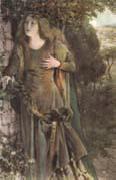 |
Louis Loeb -- Click Here
|
|
Landscape, Portrait, Figure-idylls
American 1866-1909
|
|
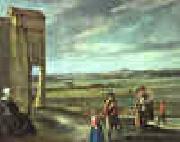 |
Louis Le Nain -- Click Here
|
|
1593-1648
French
Louis Le Nain Gallery
French family of painters. Antoine Le Nain (b Laon, c. 1600; bur Paris, 26 May 1648) and his brothers Louis Le Nain (b Laon, c. 1600; bur Paris, 24 May 1648) and Mathieu Le Nain (b Laon, c. 1607; bur Paris, 26 April 1677) lived together and shared a studio in Paris. Since the studio was headed by Antoine, he is assumed to have been older than Louis. The brothers reputation rests on a number of paintings signed Le Nain, on the basis of which other paintings (but no drawings) have also been attributed to them. None of the signed paintings bears a Christian name, and there is no secure way of attributing works to the individual brothers, although many attempts have been made. Eighteenth-century sale catalogues, fearful of anonymity, effectively chose from the three names at random. Since the writings of Witt (1910) and Jamot (1922) in particular, it has been habitual to ascribe small paintings on copper to Antoine, and austere, larger peasant scenes to Louis. This division of hands will be found in almost all the subsequent literature on the artists, although it must be stressed that there is no evidence at all to support it. Great efforts have also been made to identify works by Mathieu, since he survived his brothers by nearly 30 years and presumably continued to paint after their deaths in 1648. However, no such activity after 1648 is securely documented, and none of the surviving works bears a date later than 1647; and the arguments for a separate Mathieu oeuvre, though cogent, should not be regarded as conclusive. The outstanding feature of the work of the Le Nain brothers, and the basis of their celebrity since the mid-19th century, is the artists treatment of the poor. |
|
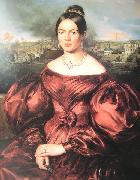 |
Louis Krevel -- Click Here
|
|
Germany (1801 -1876 ) - Painter
|
|
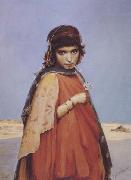 |
Louis Joseph Anthonissen -- Click Here
|
|
Belgian Painter, 1849-1913 |
|
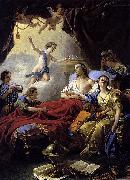 |
Louis Jean Francois Lagrenee -- Click Here
|
|
(December 30, 1724 - June 19, 1805) was a French painter, a pupil of Carlo Vanloo. His younger brother Jean-Jacques Lagren??e was also a painter.
Lagrenee was born in Paris. In 1755 he became a member of the Royal Academy, presenting as his diploma picture the Rape of Deianira (Louvre). He visited Saint Petersburg at the call of the empress Elizabeth, and on his return was named in 1781 director of the French Academy in Rome, a position he kept until 1787. He there painted the Indian Widow, one of his best-known works.
In 1804 Napoleon conferred on him the cross of the l??gion d'honneur, and on June 19, 1805 he died in the Louvre, of which he was honorary keeper.
|
|
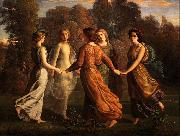 |
Louis Janmot -- Click Here
|
|
(21 May 1814 - 1 June 1892) was a French painter and poet.
Janmot was born in Lyon of Catholic parents who were deeply religious. He was extremely moved by the death of his brother in 1823 and his sister's in 1829. He became student at the Royal College of Lyon where he met Frederic Ozanam and other followers of his philosophy professor, Abbe Noirot. In 1831 he was admitted to the École des Beaux-Arts de Lyon and a year later, he won the highest honor, the Golden Laurel. In 1833, he came to Paris to take painting lessons from Victor Orsel and Jean-Auguste-Dominique Ingres. With other Lyon painters, he entered the Society of St. Vincent de Paul. In 1835, he went to Rome with Claudius Lavergne, Jean-Baptiste Frenet and other students and met Hippolyte Flandrin.
After his come back to Lyon in 1836, Janmot would attract the attention of critics of the Salon de Paris in conducting large-scale paintings with religious inspiration such as The Resurrection of the son of the widow of Nain (1839) or Christ in Gethsemane (1840). After 1845, he attracted the interest of Charles Baudelaire with his painting Flower of the Fields that allowed him to access to the Salon of 1846. Theophile Gautier was impressed by his Portrait of Lacordaire (1846). But the failure of his Poem of the Soul at the Universal Exhibition of 1855 disappointed him. In December of that year he married Leonie Saint-Paulet, from a noble family in Carpentras.
In 1856, Janmot obtained a commission to paint a fresco (since destroyed) representing the Last Supper for the church of St. Polycarp. Other orders followed, including the decoration of the dome of the Church of St. Francis de Sales and for the town hall that had been renovated by his friend the architect T. Desjardins. He was then appointed professor at the École des Beaux-Arts.
|
|
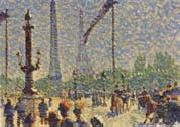 |
Louis Hayet -- Click Here
|
|
French, 1864-1940.French painter and writer. He was largely self-taught and initially earned his living as an itinerant painter-decorator. In 1881 he met Lucien and Camille Pissarro while painting landscapes near Pontoise and through them met Paul Signac in 1885 and Seurat in 1886. After a years military service at Versailles, Hayet moved to Paris in the autumn of 1887. There he began to apply to his paintings Eug?ne Chevreuls theories of colour contrast with which he had become familiar by 1881. A gifted watercolour painter, he also experimented with the ancient technique of wax encaustic, painting on a prepared cotton that allowed light to filter through. The paint surface of works such as The Grange (Beauchamp, France, priv. col., see 1983 Pontoise exh. cat., no. 1) retains a vivid tonal freshness, while the subject of crowds of peasants gathered before the Paris agricultural market reveals a debt to Pissarro. During the second half of the 1880s he became obsessed with the notion of passage |
|
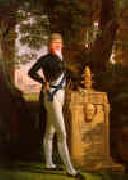 |
Louis Gauffier -- Click Here
|
|
1762-1801
French
Louis Gauffier Gallery
French painter. Following his move to Paris, where he became a pupil of Hugues Taraval and a student at the Academie Royale, in 1784 Gauffier shared the Prix de Rome with Jean-Germain Drouais and Antoine-Denis Chaudet (for sculpture), his own work being Christ and the Woman of Canaan (Paris, Ecole N. Sup. B.-A.). During his time in Rome (1785-9) Gauffier worked hard, but his health was poor and the results variable. On his return to Paris he was accepted (agree) by the Academie as a history painter. Soon after, he returned to Rome in order to escape the worsening situation in Revolutionary Paris, although he continued to send his Neo-classical works to the Salon. In March 1790 he married Pauline Chatillon (d July 1801), a portrait painter whom he and Drouais had taught.. |
|
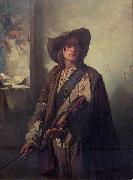 |
Louis Gallait -- Click Here
|
|
(9 or 10 May 1810 - 20 November 1887) was a Belgian painter. His d his reputation especially with the large painting of Charles V's abdication. Gallait's works were considered as the basis for a desirable renewal of historical paintings because of the realism, costume faithfulness and colorful posture of his paintings. His last artwork was sent on tour in Germany and that led to new signals even among German historians. He was also a distinguished portrait painter.
Gallait died in Brussels in 1887. There is a painting by Louis Gallait at the Norton Art Museum in West Palm Beach, Florida ("Art and Liberty").
|
|
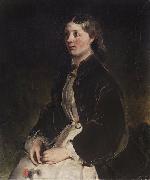 |
Louis Ferdinand von Rayski -- Click Here
|
|
Ferdinand von Rayski (1806 - 1890) was a German painter noted for his portraits.
Rayski was born in 1806 in Pegau. From 1816 to 1821 he studied drawing under Traugott Faber at the Freimaurerinstitut in Dresden and from 1823 to 1825 studied at Kunstakademie in Desseldorf. He began his career as a professional artist in 1829, painting portraits of his noble relatives in Hannover and Silesia. From 1831 to 1834 he lived in Dresden, where he received numerous portrait commissions. He traveled to Paris in 1834-35, and was influenced by the works of Delacroix, Gericault and Gros. Rayski gained a reputation as a distinguished portrait painter, but also produced animal and hunting scenes, as well as, yet less frequently, military, historical and mythological paintings. He lived in Dresden from 1840 until his death in 1890. |
|
|
|
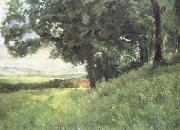 |
Louis Eysen -- Click Here
|
|
1843 - 1899
German painter and engraver. His family, which had moved to England in the 1840s, returned to Frankfurt am Main in 1850. He studied wood engraving with Alexander Stix (1819-93) at the St?delsches Kunstinstitut in Frankfurt and later achieved considerable success in this medium (e.g. Glade, 1868; see Zimmermann, p. 9). He was taught painting by Karl Hausmann (1825-86) and was influenced chiefly by contemporary French art. He first worked mainly in Berlin and then in Munich, where he met Otto Scholderer and Wilhelm Leibl, who painted his portrait (c. 1870; Frankfurt am Main, Stedel. Kstinst.). He studied with Leon Bonnat in Paris from 1869 to 1870. In 1873 he settled at Kronberg, |
|
 |
Louis emile pinel de Grandchamp -- Click Here
|
|
Beaune 1831-1894 |
|
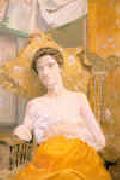 |
Louis Eilshemius -- Click Here
|
|
1864-1941
Louis Eilshemius Gallery
Born near Newark, New Jersey into a wealthy family, his earliest education was in Europe, after which he spent two years at Cornell University before his art studies began at the Art Students League of New York. He subsequently studied under Bouguereau at the Acad??mie Julian in Paris, and traveled widely in Europe, Africa and the South Seas, returning to the family brownstone in New York City where he was to live for the rest of his life.
His early landscapes, which show the influence of the Barbizon school and of Corot, George Inness and Albert Pinkham Ryder, gained him little recognition from critics or from the public. Around 1910, the element of fantasy in his work became more pronounced and his technique became coarser; henceforth, he often painted on cardboard instead of canvas. As his works became more idiosyncratic, so did his behavior, and he developed an unsettling habit of visiting galleries and loudly condemning the works on display.
His later, visionary works depicting moonlit landscapes populated with voluptuous nymphs caused his contemporaries particular consternation, due to their crudely rendered and often extravagantly smiling nudes. These are shown frolicking in forests or waterfalls, either alone or in groups, sometimes defying gravity by floating through the air. His paintings of New York rooftops are as lyrical as his pastoral scenes, and like them are often bounded by sinuous "frames" he painted onto his pictures.
Eilshemius also wrote verse and prose, composed music, painted, philosophized and became notorious for his numerous, often vitriolic, letters-to-the-editor of various New York City publications. His lack of public acclaim led him to desperate measures: suspecting that the length of his name was responsible for his neglect, in about 1890 he began signing his paintings "Elshemus" (he reverted back to the original spelling in 1913). On letterheads and in hyperbolic, self-published flyers he would proclaim his accomplishments: "Educator, Ex-actor, Amateur All-around Doctor, Mesmerist-Prophet and Mystic, Reader of Hands and Faces, Linguist of 5 languages", as well as world-class athlete and marksman, "Spirit-Painter Supreme", and musician whose improvisations rivalled the compositions of Chopin. All of this only reinforced the impression, already suggested by the peculiar imagery in many of his paintings, that he was either mad or a charlatan.
He was not without supporters, however. He was championed by Marcel Duchamp, who "discovered" Eilshemius in 1917 and invited him to exhibit with him in Paris that year. His work was generally well received by French viewers and critics; his admirers included Matisse. Duchamp subsequently helped to arrange Eilshemius's first solo exhibition in 1920, at the Soci??t?? Anonyme in New York City. The hostile critical reception to this exhibition, however, finally drove him to give up painting entirely in 1921, although there is a single known painting dated 1937. The remainder of his life was dedicated to self-promotion, and in 1931 he took to referring to himself as "Mahatma".
Injured in an automobile accident in 1932, he became increasingly reclusive. His health in decline and his family fortune spent, he died in 1941.
Since his death, Eilshemius's work has found a wider audience. One of the artist's few consistent patrons, Roy Neuberger, donated a large body of Eilshemius' work to the Neuberger Museum of Art located at SUNY Purchase College in New York State. |
|
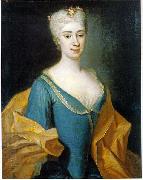 |
Louis de Silvestre -- Click Here
|
|
(23 June 1675 - 11 April 1760) was a French portrait and history painter. He was court painter to King Augustus II of Poland, and director of the Royal Academy of Arts in Dresden.
Sylvestre was born in Sceaux, south of Paris, the third son of Israel Silvestre, the notable engraver and drawing-master to the Dauphin himself. Louis was taught initially by his father, then trained under Charles Le Brun and Bon Boullogne; he completed his studies in Rome, where he met Carlo Maratta, whose work had a great influence on him.
After his return to Paris, Sylvester entered the Royal Academy in 1702 and was appointed professor in 1706. |
|
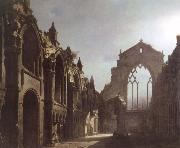 |
louis daguerre -- Click Here
|
|
Louis-Jacques-Mand?? Daguerre (November 18, 1787 ?C July 10, 1851) was a French artist and chemist, recognized for his invention of the daguerreotype process of photography.
Daguerre was born in Cormeilles-en-Parisis, Val-d'Oise, France. He apprenticed in architecture, theater design, and panoramic painting. Exceedingly adept at his skill for theatrical illusion, he became a celebrated designer for the theater and later came to invent the Diorama, which opened in Paris in July 1822.
In 1827, Joseph Nic??phore Ni??pce produced the world's first permanent photograph (known as a Heliograph). Daguerre partnered with Ni??pce two years later, beginning a four-year cooperation. Ni??pce died suddenly in 1833. The main reason for the "partnership", as far as Daguerre was concerned, was connected to his already famous dioramas. Niepce was a printer and his process was based on a faster way to produce printing plates. Daguerre thought that the process developed by Niepce could help speed up his diorama creation.
Daguerre announced the latest perfection of the Daguerreotype, after years of experimentation, in 1839, with the French Academy of Sciences announcing the process on January 7 of that year. Daguerre's patent was acquired by the French Government, and, on August 19, 1839, the French Government announced the invention was a gift "Free to the World."
Daguerre and Ni??pce's son obtained a pension from the Government in exchange for freely sharing the details of the process. Daguerre died in Bry-sur-Marne, 12 km from Paris. A monument marks his grave there.
|
|
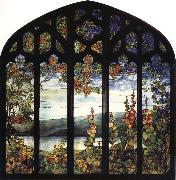 |
Louis Comfort Tiffany -- Click Here
|
|
American Art Nouveau Stained Glass Artist, 1848-1933
was an American artist and designer who worked in the decorative arts and is best known for his work in stained glass and is the American artist most associated with the Art Nouveau and Aesthetic movements. Tiffany was affiliated with a prestigious collaborative of designers known as the Associated Artists which included Lockwood de Forest, Candace Wheeler, and Samuel Colman. Tiffany designed stained glass windows and lamps, glass mosaics, blown glass, ceramics, jewelry, enamels and metalwork Louis was the son of Charles Lewis Tiffany, founder of Tiffany and Company; and Harriet Olivia Avery Young. Louis married Mary Woodbridge Goddard (c1850-1884) on May 15, 1872 in Norwich, Connecticut and had the following children: Mary Woodbridge Tiffany (1873-1963) who married Graham Lusk; Charles Louis Tiffany I (1874-1874); Charles Louis Tiffany II (1878-1947); and Hilda Goddard Tiffany (1879-1908). After the death of his wife, he married Louise Wakeman Knox (1851-1904) on November 9, 1886. They had the following children: Louise Comfort Tiffany (1887-1974); Julia DeForest Tiffany (1887-1973) who married Gurdon S. Parker then married Francis Minot Weld; Annie Olivia Tiffany (1888-1892); and Dorothy Trimble Tiffany (1891-1979). Many of Tiffany's descendants are active in the arts, politics, and the sciences. Only one descendant is working in glass today- Dr. Rodman Gilder Miller of Seattle, WA, |
|
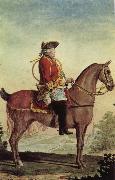 |
Louis Carrogis Carmontelle -- Click Here
|
|
August 15, 1717?CDecember 26, 1806,was a French dramatist, painter and architect; author of little pieces under the name of Proverbes. |
|
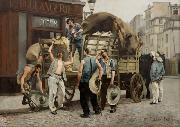 |
Louis Carrier-Belleuse -- Click Here
|
|
(1848-1913) was a French painter and sculptor.
He was son and pupil of Albert-Ernest Carrier-Belleuse. He designed the patterns of the Faïencerie (earthenware factory) from Choisy-le-Roi, where he was artistic director. He was also the sculptor of the Equestrian monument to General Manuel Belgrano
|
|
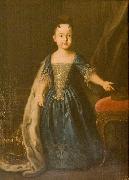 |
Louis Caravaque -- Click Here
|
|
Louis Caravaque, a French portrait painter, was a native of Gascony. He went to Russia, and in 1716 painted at Astrakhan the portrait of Peter the Great, which has been engraved by Massard and by Langlois. He again painted the Czar in 1723, and subsequently the Empresses Anne and Elizabeth. He died in Russia in 1752. |
|
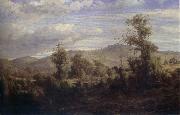 |
Louis Buvelot -- Click Here
|
|
Swiss-born Australian Painter
1814-1888
was a Swiss-born landscape painter who emigrated to Australia in 1865 and influenced the Heidelberg School of painters. Buvelot was born in Morges, Vaud, Switzerland, second son of Francois Simeon Buvelot, postal official, and his wife Jeanne-Louise nee Heizer, a school teacher. Louis Buvelot worked under Marc-Louis Arland at Lausanne, and from around 1834 continued his studies at Paris with Camille Flers, a well-known landscape painter of the day. After a few months there he migrated to Bahia, Brazil where he worked on his uncle's coffee plantation. In October 1840 Buvelot moved to Rio de Janeiro and attracted the notice of the emperor Dom Pedro II, who bought some of his pictures and decorated him with the Order of the Rose. In November 1843 Buvelot married Marie-Felicite, nee Lalouette (born 1816). Buvelot returned to Switzerland in 1852 and in 1856 was awarded a silver medal for a picture exhibited at Berne. |
|
|
|
|
|
 |
Louis Anquetin -- Click Here
|
|
1861-1932,French painter. He came to Paris in 1882 and studied art at the Ateliers of Bonnat and Cormon, where he was a contemporary and friend of Henri de Toulouse-Lautrec, Emile Bernard and Vincent van Gogh. His early work shows the influence of Impressionism and of Edgar Degas. In 1887 Anquetin and Bernard devised an innovative method of painting using strong black contour lines and flat areas of colour; Anquetin aroused much comment when he showed his new paintings, including the striking Avenue de Clichy: Five O'Clock in the Evening (1887; Hartford, CT, Wadsworth Atheneum) at the exhibition of Les XX in Brussels and at the Salon des Independants in Paris in 1888. The new style, dubbed Cloisonnisme by the critic Edouard Dujardin (1861-1949), resulted from a study of stained glass, Japanese prints and other so-called 'primitive' sources; it was close to the Synthetist experiments of Paul Gauguin and was adopted briefly by van Gogh during his Arles period. Anquetin's works were shown alongside Gauguin's and Bernard's at the Caf? Volpini exhibition in 1889, |
|
|
|
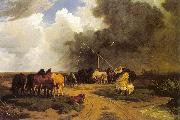 |
Lotz, Karoly -- Click Here
|
|
Hungarian Painter, 1833-1904
was a German-Hungarian painter. Karl Lotz was born in Bad Homburg vor der Höhe, Germany, the seventh and youngest surviving child of Wilhelm Christian Lotz and Antonia Höfflick. His father was a valet of Prince Gustav zu Hessen-Homburg at the time when the prince was representing Austria at the Congress of Vienna, which among other matters dealt with the House of Hessen-Homburg's rights of sovereignty over Hessen-Darmstadt. The sudden death of the young Baron von Sinclair, charge d'affaires, forced W. C. Lotz temporarily into the rôle. While in Hungary in 1815 he made the acquaintance of the 13-year-old Antonie Hoefflich, whom he married three years later. She gave birth to eight children, of whom Karl was the youngest. W. C. Lotz died in 1837 and Antonie moved the family to Pest (now that part of Budapest to the north of the River Danube). Karl attended the Piaristengymnasium, where, although Calvinist, he was awarded a scholarship for his exceptional academic performance. He began his artistic career as a pupil of the Hofkapellmeister Destouches, then in the academy of the Venetian master Jacopo Marastoni (1804-1860). Later he was a pupil of the historical painters Henrik Weber (1818-1866) in Budapest and Carl Rahl (1812-1865) in Vienna. Together with Rahl he worked on numerous commissions. Later he started on his own original works, first as a romantic landscape artist in scenes of the Alföld (the Hungarian lowland plain), and then as a creator of monumental murals and frescos in the style of the Venetian master Tiepolo. After various works in Budapest he became active in Vienna. He laid out plans for a grandiose palace, and completed murals commissioned by the Abbot of Tihany for his abbey church on the shore of Lake Balaton. He became known for his portraits and nudes, for which both his wife and his daughters (Katarina in particular) posed. Lotz found married bliss only at the age of 58, when he married the widow Jacoboy, the former wife of his brother Paul Johann Heinrich, who had died in 1828. From then on he signed his works Keroly Jacoboy-Lotz. In 1882 Lotz was appointed Professor at various art academies in Budapest, and in 1885 he became dean of a newly-established department for women painters. |
|
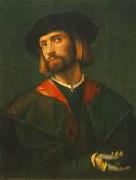 |
LOTTO, Lorenzo -- Click Here
|
|
Italian High Renaissance Painter, ca.1480-1556
Italian painter and draughtsman. He had a long and often prosperous career as a painter, and, although he travelled widely, his style retained a close affinity with the paintings of his native Venice. He was one of an outstanding generation of painters, including Giorgione, Titian, Palma Vecchio and Pordenone, who appeared in Venice and the Veneto during the first decade of the 16th century. In comparison with his contemporaries, Lotto was a fairly traditional painter in that he worked primarily in the long-established genres of altarpieces, devotional pictures and portraiture. Such paintings were popular in the Venetian provinces and the Marches where Lotto spent much of his career and where he often received more money for his commissions than he could obtain in Venice. His most important commissions were for altarpieces, and he is perhaps best known for a series of sacre conversazioni in which he skilfully varied the symmetrical groupings of figures found in earlier Venetian treatments of the subject by Giovanni Bellini and Alvise Vivarini. Precedents in Venice were also important for Lotto's early efforts in bust-length portraiture, but from 1525 he made a considerable contribution to the development of the three-quarter-length portrait. He painted many private devotional paintings but only a few of the historical, mythological or allegorical scenes that were popular in northern Italy in this period. Lotto is one of the best-documented painters of the 16th century: 40 autograph letters dating from 1524 to 1539, |
|
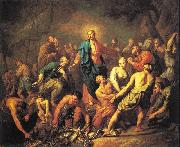 |
Losenko, Anton -- Click Here
|
|
Russian Painter, 1737-1773
Ukrainian painter, active in Russia. He trained (1753-8) under Ivan Argunov, and from 1758 he was a student at the recently founded Academy of Art in St Petersburg, where he later taught. From 1760 to 1769 he spent time in Paris, where he studied at the Acad?mie Royale de Peinture et de Sculpture under Jean Reteux (1692-1768) and Joseph-Marie Vien. He then studied in Rome. |
|
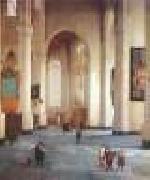 |
LORME, Anthonie de -- Click Here
|
|
Dutch painter (b. ca. 1610, Tournai, d. 1673, Rotterdam) |
|
 |
Lorenzo Veneziano -- Click Here
|
|
actice in venice 1356-1372 |
|
|
|
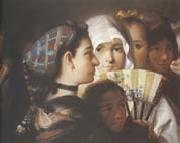 |
Lorenzo Tiepolo -- Click Here
|
|
Venice 1736 -C Madrid 1776
|
|
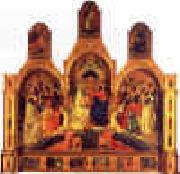 |
Lorenzo Monaco -- Click Here
|
|
Italian
c1370-c1424
Lorenzo Monaco Gallery
was a Florentine painter. He joined the Camaldolese monastery of Santa Maria degli Angeli in Florence in 1391, but he left monastic life before making a lifetime commitment. Despite this fact, he has traditionally been called "Lawrence the Monk." His work shows the influence of the International Gothic style of the late fourteenth century, as well as that of the Sienese school. |
|
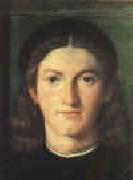 |
Lorenzo Lotto -- Click Here
|
|
Italian
1480-1556
Lorenzo Lotto Galleries
In this last period of his life, Lorenzo Lotto would frequently move from town to town, searching for patrons and commissions. In 1532 he went to Treviso. Next he spent about seven years in the Marches (Ancona, Macerata en Jesi), returning to Venice in 1540. He moved again to Treviso in 1542 and back to Venice in 1545. Finally he went back to Ancona in 1549.
This was a productive period in his life, during which he painted several altarpieces and portraits :
Santa Lucia before the Judge, 1532, Jesi, Pinacoteca comunale
The Sleeping Child Jesus with the Madonna, St. Joseph and St. Catherine of Alexandria, 1533, Bergamo, Accademia Carrara
Portrait of a Lady as Lucretia, 1533, National Gallery, London.
Holy Family with SS Jerome, Anna and Joachim, 1534, Firenze, Uffizi
Holy Family, ca 1537, Paris, Louvre
Portrait of a Young Man, Firenze, Uffizi
Crucifixion, Monte San Giusto, Church of S Maria in Telusiano
Rosary Madonna, 1539, Cingoli, Church of San Nicolo
Portrait of a Man, 1541, Ottawa, National Gallery of Canada
Bust of a Bearded Man, 1541, ascribed, San Francisco, Fine Arts Museum
The Alms of Saint Anthony, 1542, Venezia, church SS Giovanni e Paolo
Madonna and four Saints, 1546, Venezia, Church of San Giacomo dell??Orio
Portrait of fra?? Gregorio Belo da Vicenza, 1548,New York, Metropolitan Museum
Assumption, 1550, Ancona, church San Francesco alle Scale
The Crossbowman, 1551, Rome, Pinacoteca Capitolina
Portrait of an Old man, ascribed, ca 1552, Saint Petersburg, Ermitage
Presentation in the Temple, 1555, Loreto, Palazzo Apostolico
A Venetian woman in the guise of Lucretia (1533).At the end of his life it was becoming increasingly difficult for him to earn a living. Furthermore, in 1550 one of his works had an unsuccessful auction in Ancona. As recorded in his personal account book, this deeply disillusioned him. As he had always been a deeply religious man, he entered in 1552 the Holy Sanctuary at Loreto, becoming a lay brother. During that time he decorated the basilica of S Maria and painted a Presentation in the Temple for the Palazzo Apostolico in Loreto. He died in 1556 and was buried, at his request, in a Dominican habit.
Giorgio Vasari included Lotto's biography in the third volume of his book Vite. Lorenzo Lotto himself left many letters and a detailed notebook (Libro di spese diverse, 1538-1556), giving a certain insight in his life and work. Among the many painters he influenced are likely Giovanni Busi |
|
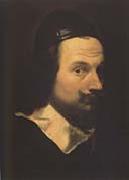 |
Lorenzo Lippi -- Click Here
|
|
1606-65
Italian painter and poet. He was trained by Matteo Rosselli, with whom he worked for many years in close partnership. His collaboration was sometimes anonymous but is documented from 1622, when they decorated the ceiling of the Sala della Stufa (Florence, Pitti), to 1631-2, when they worked together on lunettes portraying St Francis Adoring the Child and St Catherine in Prison (Florence, S Gaetano). In 1630 Lippi was enrolled in the Accademia del Disegno but appears not to have had his own workshop until after 1634, although he worked independently before then. The earliest paintings attributable to him are, both in facial types and in the soft, rich folds of the drapery, close in style to the work of Rosselli. Examples include canvases of the Apostles James, John and Matthew, and Christ Blessing (all 1628; Vaglia, S Pietro), and the Virgin Handing the Child to St Francis (1629; Florence, S Salvatore di Camaldoli). In the 1630s Lippi painted decorative and theatrical compositions, mainly on literary and biblical themes, which remained indebted to Rosselli, for example Samson and Delilah (1632; Stockholm, Nmus.) and the Virgin in Glory with Saints (1634; Ronta, nr Barberino di Mugello, S Michele). Shortly afterwards he produced works |
|
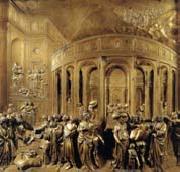 |
Lorenzo Ghiberti -- Click Here
|
|
Italian Early Renaissance Sculptor, 1378-1455 |
|
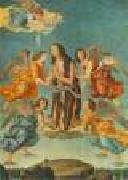 |
LORENZO DI CREDI -- Click Here
|
|
Italian High Renaissance Painter, ca.1458-1537 |
|
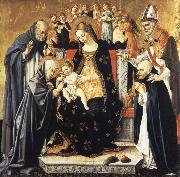 |
Lorenzo di Alessandro da Sanseverino -- Click Here
|
|
Italian Early Renaissance Painter, active 1468-1503 |
|
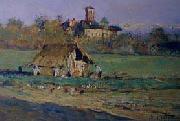 |
Lorenzo Delleani -- Click Here
|
|
(Pollone (Biella), 1840 - Turin, 1908) was an Italian painter.
A pupil of Cesare Gamba and Carlo Arienti at the Albertina Academy in Turin, Delleani worked initially in the field of history painting and received various marks of official recognition. He exhibited work at the Paris Salon of 1874 and gradually modernised his means of expression and range of subjects at the end of the decade with a new focus on landscape and painting from life. The early 1880s saw an exclusive focus on painting en plein air, capturing light in thick strokes of colour. His most frequent subjects were views of the Piedmontese and Lombard countryside in changing conditions of light and season. The artistes presentation of some 40 works at the Venice Biennale in 1905 and participation in the International Exhibition in Munich of the same year set the seal on his international success.
|
|
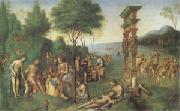 |
Lorenzo Costa -- Click Here
|
|
Bologna 1460-Mantua 1535
was an Italian painter of the Renaissance. He was born at Ferrara, but moved to Bologna by the his early twenties, and would be more influential to the Bolognese school of painting. However, many artists worked in both nearby cities, and thus others consider him a product of the School of Ferrara. There are claims that he trained with Cosimo Tura. In 1483 he painted his famous Madonna and Child with the Bentivoglio family, and other frescoes, on the walls of the Bentivoglio chapel in San Giacomo Maggiore, and he followed this with many other works. He was a great friend of Francesco Francia, who was much influenced by him. In 1509 he went to Mantua, where his patron was the Marquis Francesco Gonzaga, and he eventually died there. His Madonna and Child enthroned is in the National Gallery, London, but his chief works are at Bologna. His sons, Ippolito and Girolamo, were also painters, and so was Girolamo's son, Lorenzo the younger (1537-1583). |
|
 |
Lorenzo Costa -- Click Here
|
|
1460-1535
Italian
Lorenzo Costa Locations
Italian painter of the Ferrarese and Bolognese schools. Trained in the manner of such painters as Tura and Cossa, he modified the strident Ferrarese style when he became a partner of Francia. Among his paintings are the Madonna and Child with the Bentivoglio Family and the Triumphs of Petrarch in San Giacomo Maggiore, the Madonna with Saints in San Petronio, and the Madonna in San Giovanni in Monte, all in Bologna. His Three Saints is in the Metropolitan Museum. |
|
|
|
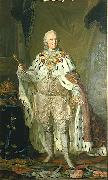 |
Lorens Pasch the Younger -- Click Here
|
|
(1733-1805) was a Swedish painter
He grew up in an artistic family (he was the brother of Ulrika Pasch, alongside whom he was elected to the Art Academy in 1773), but his father Lorens Pasch the Elder wanted him to become a priest. He was thus sent to study in Uppsala aged 10. However, he decided on an artistic career after all and began an apprenticeship in his father's studio before going to Copenhagen, with introductions from his wealthy and influential uncle Johan Pasch. There he studied painting for three years in the studio of Carl Gustaf Pilo. Despite good offers of studio-apprenticeships and commissions from Sweden, he then set off for Paris in 1758 to complete his artistic education. There he specialised in history painting in the studios of Eustache Le Sueur and François Boucher (though for financial reasons he also continued his training in portraiture) and became friends with fellow-Swede Alexander Roslin.
In 1764 he left Paris and got back to Sweden in 1766. He fully completed his training in the studio of the French painter Guillaume Taraval, who in 1735 founded the Royal Swedish Academy of Arts in Stockholm. Soon after his arrival back in Sweden Pasch's gained a great reputation as a portraitist, gaining favour and commissions from the royal court and gaining the esteem of Adolf Frederick, King of Sweden and his queen Louisa Ulrika - one of his most notable works is his Portrait of Louisa Ulrika of Prussia. He served as a professor at the Academy of Arts from 1773 to his death, becoming its director on Pilo's death in 1793. At the end of his life he concentrated more on training young artists and managing the Academy than on painting. He died unmarried in 1805 and due to his powerful portraits remains one of the most respected painters of the Gustavian era in Sweden. |
|
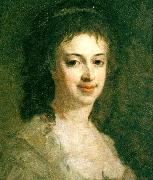 |
lorens pasch d.y -- Click Here
|
|
Lorens Pasch d.y., född 1733, död 1805, konstnär; professor vid Konstakademien från 1773. Son till Lorens Pasch d.ä., bror till Ulrika Pasch, brorsson till Johan Pasch. Invald tillsammans med sin syster i Konstakademien 1773. |
|
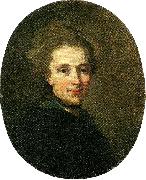 |
lorens pasch d. y -- Click Here
|
|
Lorens Pasch d.y., född 1733, död 1805, konstnär; professor vid Konstakademien från 1773. Son till Lorens Pasch d.ä., bror till Ulrika Pasch, brorsson till Johan Pasch. Invald tillsammans med sin syster i Konstakademien 1773. |
|
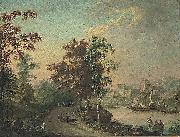 |
Lorens Gottman -- Click Here
|
|
(1708 -1779 ) - Painter
|
|
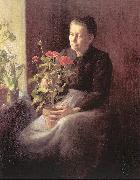 |
Lord, Caroline A. -- Click Here
|
|
American, 1860-1927 |
|
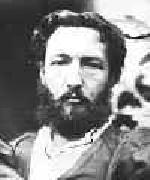 |
Lord Frederic Leighton -- Click Here
|
|
British
1830-1896
Lord Frederic Leighton Locations
|
|
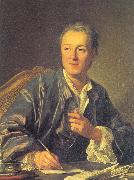 |
Loo, Louis-Michel van -- Click Here
|
|
Flemish active in France, 1707-1771
Painter, son of Jean-Baptiste van Loo. He trained with his father in Turin and Rome, later attending the courses of the Acad?mie Royale in Paris. He received the institution's first prize for painting in 1726, and in 1728, accompanied by his brother, Fran?ois, and his uncle, Carle, returned to Rome where he was associated with Francois Boucher. On his way back to France, he stayed for a time in Turin, painting portraits of the royal family of Sardinia, the Duke and Duchess of Savoy. In Paris he was admitted to membership of the Acad?mie Royale and in 1735 was appointed assistant teacher at the Academie, becoming renowned as a specialist in portrait painting. Most of his portraits from this period are half-length, combining ideas from Hyacinthe Rigaud's later work with other more natural and innovative ones. On the death of Jean Ranc, Philip V of Spain asked Rigaud to suggest a substitute, and van Loo was proposed. He arrived in Madrid in 1737 and remained there as Pintor de la Corte until 1752, responding with modern aesthetic ideas to the demands of the Spanish monarchs for pomp and splendour. He carried out court commissions but devoted part of his time to teaching, his pupils often becoming studio assistants. He also took an active part in meetings held over a number of years to establish the Real Academia de Bellas Artes de S Fernando, for which he produced the canvas, the Education of Cupid by Venus and Mercury |
|
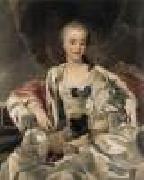 |
LOO, Louis Michel van -- Click Here
|
|
French painter (b. 1707, Toulon, d. 1771, Paris).
Painter, son of Jean-Baptiste van Loo. He trained with his father in Turin and Rome, later attending the courses of the Academie Royale in Paris. He received the institution's first prize for painting in 1726, and in 1728, accompanied by his brother, Francois, and his uncle, Carle, returned to Rome where he was associated with Francois Boucher. On his way back to France, he stayed for a time in Turin, painting portraits of the royal family of Sardinia, the Duke and Duchess of Savoy. In Paris he was admitted to membership of the Academie Royale and in 1735 was appointed assistant teacher at the Academie, becoming renowned as a specialist in portrait painting. Most of his portraits from this period are half-length, combining ideas from Hyacinthe Rigaud's later work with other more natural and innovative ones. On the death of Jean Ranc, Philip V of Spain asked Rigaud to suggest a substitute, and van Loo was proposed. He arrived in Madrid in 1737 and remained there as Pintor de la Corte until 1752, responding with modern aesthetic ideas to the demands of the Spanish monarchs for pomp and splendour. He carried out court commissions but devoted part of his time to teaching, his pupils often becoming studio assistants. He also took an active part in meetings held over a number of years to establish the Real Academia de Bellas Artes de S Fernando, for which he produced the canvas, the Education of Cupid by Venus and Mercury |
|
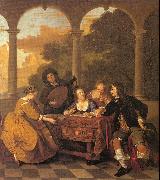 |
Loo, Jacob van -- Click Here
|
|
Flemish Baroque Era Painter, 1614-1670
was a Dutch painter and popularized around 1650 a close-focus concert on a loggia or terrace. So Van Loo became known for his conversation groupings with a subtle color palette, and according to Arnold Houbraken famous for his nudes. He was the founder of the Van Loo family of painters. Van Loo was born in Zeeland in the Dutch Republic. His father might have been a notary, but most time he is regarded as the son of a painter, Jan van Loo, who trained him. (As part of the city archives in Sluis have been destroyed during World War II it is impossible now to make out what is true). His early influences include Thomas de Keyser and Jacob Adriaensz Backer. In 1642, Jacob moved to Amsterdam, where his contemporaries included Rembrandt, Frans Hals, and Bartholomeus van der Helst. In 1643 he married the sister of the painter Martinus Lengele and had six children. They lived on Rozengracht, in the Jordaan and Eglon van der Neer became one of his pupils. In 1660, Van Loo fled the city after having fatally stabbed someone in his belly, during a fight in an inn. He was sentenced to death in absentia and was forever banned from the state of Holland. Van Loo settled in Paris, where he was admitted to the Acad??mie de peinture et de sculpture and where he died in 1670. Van Loo's work was done in the Baroque style, which had begun in Rome and which was becoming a Europe-wide phenomenon in this period. He was a major influence on Johannes Vermeer, when painting Diana and Her Companions. He painted portraits of Johan Huydecoper van Maarssenveen, his wife, his sister Leonara Huydecoper, married to Jan J. |
|
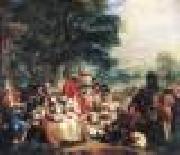 |
LOO, Carle van -- Click Here
|
|
French painter (b. 1705, Nice, d. 1765, Paris). |
|
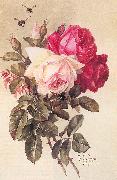 |
Longpre, Paul De -- Click Here
|
|
French, practiced mainly in America, 1855-1911
was a French flower painter, actively chiefly in the United States. He was born in Lyons, France, and was entirely self-taught. From his twelfth year he practiced successfully in Paris as a painter of fans. At 21 he first exhibited at the Salon. Having lost his money by the failure of a Paris bank, he moved in 1890 to New York and in 1896 held an exhibition of flower pieces which secured him instant recognition. In 1899 he moved to California and two years later built a beautiful house at Hollywood, which became celebrated for its magnificent flower gardens. De Longpre painted only perfect specimens of flowers; with delicacy of touch and feeling for bosoms he united scientific knowledge, and he also knew how to give expression to the subtle essence of the flowers. |
|
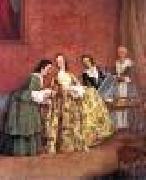 |
LONGHI, Pietro -- Click Here
|
|
Italian Rococo Era Painter, ca.1702-1785
Painter and draughtsman. His father, Alessandro Falca, encouraged his natural talent for drawing, and he studied under Antonio Balestra for 'several years', according to his son, Alessandro Longhi. Balestra probably took Pietro to Bologna and recommended him to Giuseppe Maria Crespi. No documents exist on Longhi until 1732, the year he married, and some doubt has been expressed about his study with Crespi. There is no trace of Crespi's influence in Longhi's altarpiece for the parish church of S Pellegrino in Bologna, St Pellegrino Condemned to Death, installed in 1732; Crespi's style is an intimate one, however, and would have been inappropriate for such a large altarpiece. One of Longhi's first independent works, the St Pellegrino altarpiece recalls his Venetian origins and training in its broken brushwork and colour glazes. In another early work, the Adoration of the Magi (Venice, Scuola Grande S Giovanni Evangelista), documented in 1733 as at S Maria Materdomini, Venice, the subject-matter lends itself to a more domestic treatment, and Crespi's influence is evident. Both these works contain passages anticipating Longhi's subsequent development as a genre painter; in each picture a boy or young man, perhaps a self-portrait, gazes out at the spectator, unconcerned with events in the painting. |
|
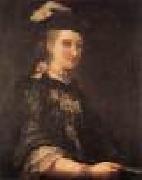 |
LONGHI, Alessandro -- Click Here
|
|
Italian painter, Venetian school (b. 1733, Venezia, d. 1813, Venezia).
Painter, engraver and writer, son of (1) Pietro Longhi. He must have received his first artistic training from his father, although the only evidence of this is the similarity of their styles. He was apprenticed to Giuseppe Nogari, one of the better Venetian portrait painters of the first half of the eighteenth century, and his earliest works are bust-length, mostly life-size portraits in Nogari's style. He first exhibited in 1757 and by 1758 must have been considered a reasonably established artist, |
|
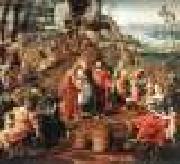 |
LOMBARD, Lambert -- Click Here
|
|
Flemish Northern Renaissance Painter, 1505-1566
Flemish painter, draughtsman, architect, humanist and numismatist. He belonged to the generation of artists who sought to revive Flemish painting by turning to the art of antiquity and the Italian Renaissance. However, because of his northern training, he assimilated his models with difficulty and produced a hesitant form of art, one that was academic and cold. He was nonetheless an important innovator in the Low Countries through his investigation of the forms and compositions of Classical art. |
|
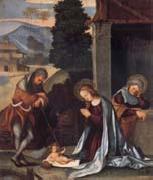 |
Lodovico Mazzolino -- Click Here
|
|
Italian High Renaissance Painter, 1480-1528 |
|
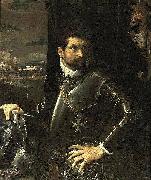 |
Lodovico Carracci -- Click Here
|
|
(21 April 1555 - 13 November 1619) was an Italian, early-Baroque painter, etcher, and printmaker born in Bologna.
Ludovico himself apprenticed under Prospero Fontana in Bologna and traveled to Florence, Parma, and Venice, before returning to his hometown. Along with his cousins Annibale and Agostino Carracci, Ludovico in 1585 was a founder and director (caposindaco) of the so-called Eclectic Academy of painting (also called the Accademia degli Incamminati), which in reality was a studio with apprenticed assistants. This studio however propelled a number of Emilian artists to pre-eminence in Rome and elsewhere, and singularly helped encourage the so-called Bolognese School) of the late 16th century, which included Albani, Guercino, Sacchi, Reni, Lanfranco and Domenichino. The Carracci had their apprentice draw studies focused on observation of nature and natural poses, and use a bold scale in drawing figures. Ludovico specifically helped train Giacomo Cavedone. The Carracci are credited with reinvigorating Italian art, especially fresco art, which was subsumed with formalistic Mannerism.
Carracci's own works are characterized by a strong mood invoked by broad gestures and flickering light that create spiritual emotion.
Ludovico Carracci died in Bologna in 1619.
|
|
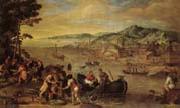 |
Lodewyck Toeput -- Click Here
|
|
Mechin ca.1545-Treviso 1610
|
|
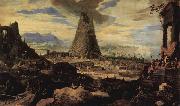 |
Lodewijk Toeput -- Click Here
|
|
(ca.1550, Antwerp - 1605, Treviso), was a Mannerist landscape painter active in Italy.
According to Karel van Mander who listed him as one of two painters from Northern Europe who he met in Venice, he was a good poet (rederijker) as well as a painter, who he thought came from Mechelen. Van Mander listed him with Dirck de Vries, a painter of kitchen pieces and fruit markets from Friesland. According to the RKD he was from Antwerp and spent most of his life in Treviso, Italy. He painted several historical allegories from the Bible and mythological themes from Metamorphoses. |
|
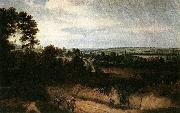 |
Lodewijk de Vadder -- Click Here
|
|
Lodewijk de Vadder (1605, Grimbergen - 1655, Brussels) was a Flemish Baroque landscape painter and engraver.
He became a master of Antwerp's Guild of St. Luke in 1628, and learned painting from his father and brothers. He specialized in landscapes with woods, in the manner of his contemporary Jacques d'Arthois and his pupil Lucas Achtschellinck[1]. They are usually referred to collectively as "The Sonian Forest Painters". |
|
|
|
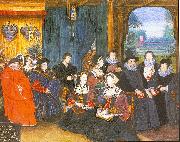 |
Lockey, Rowland -- Click Here
|
|
English Baroque Era Painter, active ca.1593-1616 |
|
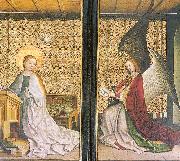 |
Lochner, Stephan -- Click Here
|
|
German Northern Renaissance Painter, ca.1400-1451 |
|
 |
Lo Scheggia -- Click Here
|
|
Italian Early Renaissance Painter, 1406-1486 |
|
|
|
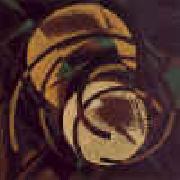 |
Ljubov Popova -- Click Here
|
|
Russian Constructivist Painter and Designer, 1889-1924
Through a synthesis of styles Popova worked towards what she termed painterly architectonics. Exploring firstly Impressionism, by 1913, in Composition with Figures, she was experimenting with the particularly Russian development of Cubo-Futurism: a fusion of two equal influences from France and Italy.
Portrait of a Philosopher (Artists's brother, Pavel Sergeyevich Popov), 1915From 1914-1915 her Moscow home became the meeting-place for artists and writers. In 1914-1916 Popova together with other avant-garde artists (Aleksandra Ekster, Nadezhda Udaltsova, Olga Rozanova) contributed to the two Jack of Diamonds exhibitions, then in Petrograd Tramway V and the 0.10, The Store in Moscow.
In 1916 she joined the Supremus group with Kazimir Malevich, the founder of Suprematism, Aleksandra Ekster, Ivan Kliun, Nadezhda Udaltsova, Olga Rozanova, Ivan Puni, Nina Genke, Ksenia Boguslavskaya and others who at this time worked in Verbovka Village Folk Centre. However there was a tension between those who like Malevich saw art as a spiritual quest and others who responded to the need for the artist to create a new physical world. Popova embraced both of these ideals but eventually identified herself entirely with the early aims of the Revolution working in poster, book design, fabric and theatre design, as well as teaching.
Her painting The Violin of 1914 reveals the development from cubism towards the "painterly architectonics" of 1917- 1918. Before joining the Supremus group her paintings, the architectonic series defined her artistic trajectory, quite distinct from that of Malevich, Rozanova, Tatlin and Mondrian, in abstract form. The canvas surface is an energy field of overlapping and intersecting angular planes in a constant state of potential release. At the same time the elements are held in a balanced and proportioned whole as if linking the compositions of the classical past to the future. By 1918 colour is used as the iconic focus; the strong primary colour at the centre drawing the outer shapes together.
In 1918 Popova married von Eding, and gave birth to a son, but von Eding died the following year of typhoid fever. She worked on Agitprop designs, and in 1919 she contributed to Tenth State Exhibition: Non Objective Creativity and Suprematism. She painted more advanced abstract works in 1919-21. In 1921 she exhibited in the 5 x 5 Exhibition.
From 1921-24 Popova became active in Constructivist projects, sometimes in collaboration with the architect Alexander Vesnin. She was active in stage designs: Vsevolod Meyerhold's production of Fernand Crommeldynck's The Magnanamous Cuckold, 1922; and in teaching: Spatial Force Constructions were used as the basis of an art teaching theory. She designed typography of books, production art and textiles, and contributed designs for dresses to LEF.
Popova died in Moscow. A large exhibition of her work opened in Moscow on 21 December 1924. |
|
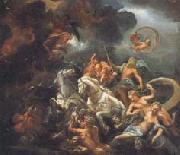 |
Livio Mehus -- Click Here
|
|
The Flemish artist (1627-1691) eclectic painter, author of landscapes, sacred objects, genre paintings and portraits embodies |
|
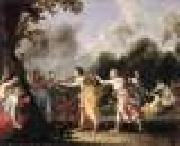 |
LISSE, Dirck van der -- Click Here
|
|
Dutch painter (b. 1607, Den Haag, d. 1669, Den Haag) |
|
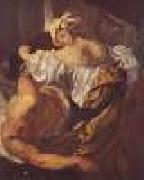 |
LISS, Johann -- Click Here
|
|
German Baroque Era Painter, ca.1597-1631 |
|
 |
Lippo Memmi -- Click Here
|
|
active in Tuscany 1317-1347 |
|
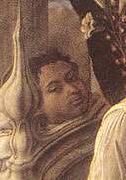 |
LIPPI, Fra Filippo -- Click Here
|
|
Italian Early Renaissance Painter, ca.1406-1469
Filippo Lippi was born in Florence. He took his vows in 1421 in the monastery S. Maria del Carmine, where Masaccio frescoed the Brancacci Chapel in the church (1426-1427). By 1430 Lippi is mentioned in church documents as "painter." Masaccio's influence, as well as Donatello's, can be seen in Lippi's early works, such as the Tarquinia Madonna of 1437 (National Gallery, Rome) and the Annunciation (S. Lorenzo, Florence) and Barbadori Altar (Louvre, Paris), both begun in 1437/1438. However, the severity of Masaccio and Donatello was mitigated by Lippi, who was instrumental in salvaging from the Gothic past the lyrical expressiveness of a linear mode which Masaccio had all but given up for modeling in chiaroscuro. Toward the middle of the 15th century Lippi's pictures became more finely articulated and his surface design more complex. It is probable that he had a large workshop, and the hand of assistants may be observed in the important fresco decoration started in 1452 in the choir chapel of the Prato Cathedral. After delays and strong protests this commission was finally completed in 1466. The cycle, a highly important monument of Early Renaissance painting, demonstrates Lippi's increasingly more mature style, revealing him to be witty, original, and well versed in all the artistic accomplishments of his time, to which he himself contributed. Through linear perspective Lippi was able to render a convincing illusion of recession and plausible three-dimensional figures. He knew how to express emotions, and he was a keen observer of nature. Lippi painted astonishing portrait likenesses and combined figures and space with an animated surface rhythm, the best example of which can be seen in the Feast of Herod, one of the last scenes in the Prato cycle. During his stay at Prato he was the cause of a scandal (later resolved by papal indulgence): he ran off with a nun, Lucrezia Buti, who bore him two children, one of whom, Filippino Lippi (ca. 1457-1504), was also a painter. In the Prato frescoes as well as in his contemporary panel pictures, such as the Madonna with Two Angels (Uffizi Gallery, Florence), or in the exquisite tondo of the Madonna (Pitti Palace, Florence), Filippo Lippi anticipated later developments in 15th-century painting. In these pictures are to be found the sources of Sandro Botticelli, Lippi's most illustrious pupil. Lippi's innovations extended also to iconography. In his quest for realism he introduced the "bourgeoise" Madonna: the type of contemporary Florentine lady elegantly dressed in the fashion of the time with the hair on her forehead plucked to stress the height of it. He also introduced the subject of the Madonna adoring the Child in the woods (Museum of Berlin, and Uffizi, Florence). |
|
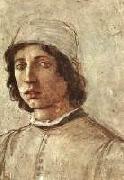 |
LIPPI, Filippino -- Click Here
|
|
Italian Early Renaissance Painter, ca.1457-1504
Son of Filippo Lippi. He was a painter of altarpieces, cassone panels and frescoes and also an exceptional draughtsman. His success lay in his ability to absorb, without slavishly following, the most popular trends in contemporary painting. He worked in Florence and Rome at a time when patrons were beginning to intermingle personal, religious, social and political ideals in their ambitions for palaces and chapels: with the support of wealthy and erudite patrons, such as Lorenzo de' Medici and Filippo Strozzi, he won important civic and private commissions. |
|
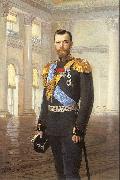 |
Lipgart, Earnest -- Click Here
|
|
Russian Painter, 1847-19 |
|
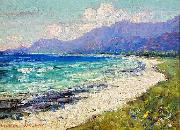 |
Lionel Walden -- Click Here
|
|
(1861-1933) was born in Norwich, Connecticut in 1861. He first became interested in art in Minnesota, where the family moved when his father became rector of an Episcopal Church there. As a young man, Walden moved to Paris where he studied painting with Carolus-Duran. In around 1893-97, Walden was in England, living in Falmouth. Paintings of Cardiff in Wales are in museums in Cardiff and Paris. Walden received medals from the Paris Salon and was made a Knight of the French Legion of Honor. He visited to Hawaii in 1911 and several times thereafter. Walden died in Chantilly, France in 1933.
According to David H. Forbes, author of Encounters with Paradise: Views of Hawaii and its People, 1778-1941, Lionel Walden "was the finest seascape painter to work in Hawaii". The Brooklyn Museum, the Henry Art Gallery (University of Washington, Seattle), the Honolulu Academy of Arts, the Isaacs Art Center (Waimea, Hawaii), and the Musee d'Orsay are among the public collections holding works by Lionel Walden.
|
|
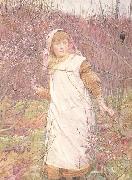 |
Lionel Percy Smythe,RA,RWS -- Click Here
|
|
1839-1918
|
|
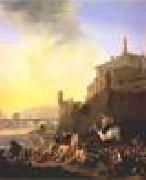 |
LINGELBACH, Johannes -- Click Here
|
|
Dutch Baroque Era Painter, 1622-1674
German painter, active in the Netherlands and Italy. By 1634 his family had settled in Amsterdam, where presumably Lingelbach trained as a painter. According to Houbraken, he visited France in 1642 and arrived in Italy two years later. However, he is not mentioned in any document of 1644, although he is recorded in Rome from 1647 to 1649. The artist left Rome in 1650 and by 1653 was back in Amsterdam, where he remained until his death. Lingelbach is perhaps the only one of the Dutch Italianates with a catalogue of numerous signed and dated works to document his artistic development. The first two signed works are The Blacksmith (1650; Rome, Melmeluzzi priv. col., see Briganti, Trezzani and Laureati, fig. 10.1) and Self-portrait with Violin (1650; Zurich, Ksthaus). Unfortunately no certain works survive from the previous years. Kren (1982) attributed a series of works depicting Roman trades, some formerly ascribed to Pieter van Laer, to Lingelbach's early career. The original group consisted of three small paintings: the Acquavita-seller, the Cake-seller and The Tobacconist (all Rome, Pal. Corsini). While these paintings have some striking points in common with the Melmeluzzi Blacksmith of 1650 and the signed Dentist on Horseback (1651; Amsterdam, Rijksmus.), it is still uncertain whether they belong to Lingelbach's pre-1650 work or are by another hand |
|
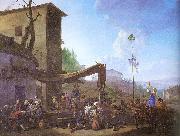 |
Lingelbach, Jan -- Click Here
|
|
Dutch Baroque Era Painter, 1622-1674 |
|
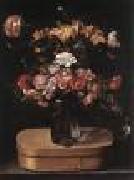 |
LINARD, Jacques -- Click Here
|
|
French Baroque Era Painter, ca.1600-1645
French painter. He was in Paris by 1626, and his first securely attributed still-life work is dated the following year. He lived in the Saint-Germain-des-Pr?s district, where a number of French still-life painters such as Louise Moillon and Lubin Baugin worked alongside Flemish artists specializing in this genre. In 1631 he was created Peintre et Valet de Chambre du Roi, a post that guaranteed him a degree of financial independence. Linard's works of 1627-44 were mainly of fruit and flowers; with Louise Moillon, however, he was among the first French artists to combine successfully the female form with still-life elements, as, for example, in Woman with Flowers and Woman with Fruit (both Paris, priv. col., see Far?, 1974, pp. 22-3). A painting such as Basket of Flowers (Paris, Louvre) owes something to Flemish prototypes in the anachronistic grouping of flowers that span several months. Patiently recording the flowers as they bloomed, and working on the picture from a series of drawings and sketches, Linard demonstrated his commitment to working from nature. However |
|
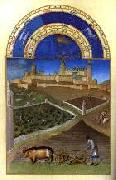 |
LIMBOURG brothers -- Click Here
|
|
Flemish painters (b. 1370-80, Nijmegen, d.
1416, Nijmegen).
family of Franco-Flemish manuscript illuminators. The Limbourg brothers, Pol, Jan, and Herman, were trained as goldsmiths. They succeeded Jacquemart de Hesdin in 1411 as court painters to Jean, duc de Berry. Their masterpiece is the magnificent book of hours known as the Tr??s Riches Heures (c.1415; Mus??e Cond??, Chantilly). This is filled with exquisite illustrations of the daily life of the aristocracy and peasantry, including a series of calendar illuminations that are considered the finest extant examples of the International Gothic style
|
|
|